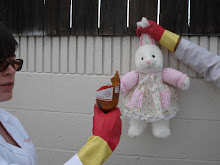It’s a stone cold fact that warmer air can hold more water than cooler air. Hence, the favorite complaint of Bingo loving, cookie baking, grandmothers everywhere “It’s not the heat, it’s the humidity!” The relationship between water vapor content (which can be quantified via vapor pressure) and temperature looks like this:

 Uh oh! Our mixing line lives in the supersaturated zone, so put your galoshes on because you’re getting rained on, buddy.
Uh oh! Our mixing line lives in the supersaturated zone, so put your galoshes on because you’re getting rained on, buddy.Another reason why we get rain is because air cools as it rises. When it cools it’s less capable of holding moisture so all the water gets dumped out. This happens in places with topographic highs like mountains. You’ll always have a rainy side of your mountain and a dry side because of this very mechanism.
Keeping with today’s theme of simple questions with not-so-simple answers: why does air cool when it rises? Let’s back up and think about US, as humans, scurrying around on the surface of our plant. We don’t think about it much, but we’re under a lot of pressure because of all that gas in the atmosphere on top of us. Gas does have mass (rhyme!), and when you’ve got miles and miles of it piled up from the Earth’s surface out into the far reaches of space, it can add some serious poundage to your daily life. Right now you are being subjected to 14.7 pounds per square inch of atmospheric pressure. Right. Now. And. Now. Still Now. It’s always there, homes. Nothing you can do about it.
Gas, however, can do something about it. As gas moves up into the atmosphere, it moves into regions of lower pressure. It can relax finally, and stretch out. It expands and when it does that it cools.
Maybe the opposite case will cement this idea in your mind: when you pump up your bike tire, what happens? The tire warms up a little because you are compressing the air inside it. This process is called adiabatic heating or cooling. Whenever a gas expands, it cools. Whenever it compresses, it warms up.
So the next time some asshole tells you that it’s raining because God is crying, tell him about vapor pressure, mixing lines, and adiabatic cooling. If this angers and confuses your Redneck friend, just follow whatever you say with “America Rules!” and you’ll be safe.


No comments:
Post a Comment